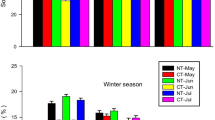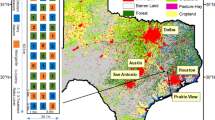Abstract
The influence of agricultural production systems on greenhouse gas generation and emission is of interest as it may affect potential global climate change. Agricultural ecosystems can play a significant role in production and consumption of greenhouse gases, specifically, carbon dioxide. Information is needed on the mechanism and magnitude of gas generation and emission from agricultural soils with specific emphasis on tillage mechanisms. This work evaluated four different tillage methods on the short-term CO2 and water vapor flux from a clay loam soil in the Northern Cornbelt of the USA. The four tillage methods were moldboard plow only, moldboard plow plus disk harrow twice, disk harrow and chisel plow using standard tillage equipment following a wheat (Triticum aestivum L.) crop compared with no tillage. The CO2 flux was measured with a large portable chamber commonly used to measure crop canopy gas exchange initiated within 5 minutes after tillage and continued intermittently for 19 days. The moldboard plow treatment buried nearly all of the residue and left the soil in a rough, loose, open condition and resulted in maximum CO2 loss. The carbon released as CO2 during the 19 days following the moldboard plow, moldboard plow plus disk harrow, disk harrow, chisel plow and not tilled treatments would account for 134%, 70%, 58%, 54% and 27% respectively of the carbon in the current year's crop residue. The short-term carbon dioxide losses 5 hours after four conservation tillage tools was only 31% of that of the moldboard plow. The moldboard plow lost 13.8 times as much CO2 as the soil area not tilled while different conservation tillage tools lost only 4.3 times. The smaller CO2 loss following conservation tillage tools is significant and suggests progress in developing conservation tillage tools that can enhance soil carbon management. Conservation tillage reduces the extent, frequency and magnitude of mechanical disturbance caused by the moldboard plow and reduces the air-filled macropores and slows the rate of carbon oxidation. Any effort to decrease tillage intensity and maximize residue return should result in carbon sequestration for enhanced environmental quality.
Similar content being viewed by others
References
Blevins RL, Smith MS & Thomas GW (1984) Changes in soil properties under no-tillage. In: Phillips RE & Phillips SH (eds) Notillage Agriculture: Principles and Practices, pp 190–230. Van Norstrand Reinhold, New York, USA
Buyanovsky GA & Wagner GH (1983) Annual cycles of carbon dioxide level in soil air. Soil Sci Soc Am J 47: 1139–1145
Buyanovsky GA, Wagner GH & Gantzer CJ (1986) Soil Respiration in a Winter Wheat Ecosystem. Soil Sci Soc Am J 50: 338–344
Currie JA (1975) Soil respiration. Min Agric Fish Food Tech Bull 29: 461–468
Denmead OT (1984) Plant physiological methods for studying evapotranspiration: Problems of telling the forest from the trees. Agric Water Manage 8: 167–189
Denmead OT (1991) Sources and sinks of greenhouse gases in the soil-plant environment. Vegetation and climate interactions in semi-arid regions. Vegetatio 91(1–2): 73–86
Gliński J & Stepniewski W (1985) Soil Aeration and its Role for Plants. CRC Press Inc, Boca Raton, FL, USA. 229 p.
Grabert D (1968) Measurements of soil respiration in a model experiment on the deepening of the arable layer. Albrecht-Thaer-Arch. 12: 681–689 (In German with English summary).
Hendrix PF, Chun-Ru H & Groffman PM (1988) Soil respiration in conventional and no-tillage agroecosystems under different winter cover crop rotations. Soil Till Res 12: 135–148
Houghton RA, Hobbie JE, Melillo JM, More B, Peterson BJ, Shaver GR & Woodwell GR (1983) Changes in the carbon content of terrestrial biota and soils between 1860–1980: A net release of CO2 to the atmosphere. Ecol Monogr 53: 235–262
Kanemasu ET, Powers WL & Sij JW (1974) Field chamber measurements of CO2 flux from soil surface. Soil Sci 118: 233–237
Kern JS & Johnson MG (1991) The impact of conservation tillage use on soil and atmospheric carbon in the contiguous United States. US EPA Report EPA/600/3-91/056. 28 p
Parkinson KJ (1981) An improved method for measuring soil respiration in the field. J Appl Ecol 18: 221–228
Post WM, Peng TH, Enamuel WR, King AW, Dale VH & DeAngelis DL (1990) The global carbon cycle. Am Sci 78: 310–326
Pritchard DT & Brown NJ (1979) Respiration in cropped and fallow soil. J Agric Sci, Cambridge 92: 45–51
Reicosky DC (1990) Canopy gas exchange in the field: Closed chambers. Remote Sensing Rev 5(1): 163–177
Reicosky DC, Wagner SW & Devine OJ (1990) Methods of calculating carbon dioxide exchange rate for maize and soybean using a portable field chamber. Photosynthetica 24(1): 22–38
Reicosky DC & Lindstrom MJ (1993) The effect of fall tillage method on short-term carbon dioxide flux from soil. Agron J 85: 1237–1243
Reicosky DC (1995) Soil variability and carbon dioxide loss after moldboard plowing. In: Robert PC, Larson WE & Rust RH (eds) Proc Second Intl Conf on Site-Specific Management for Agric Systems, Chap 63, pp 847–865. Am Soc Agron, Madison, WI, USA
Reicosky DC & Lindstrom MJ (1995) Impact of fall tillage and short-term carbon dioxide flux. In: Lal R, Kimble J, Levine E & Stewart BA (eds) Soil and Global Change, pp 177–187. Lewis Publishers Chelsea, Michigan, USA
Reicosky DC, Kemper WD, Langdale GW, Douglas CL Jr & Rasmussen PE (1995) Soil organic matter changes resulting from tillage and biomass production. J Soil Water Conserv 50(1): 253–261
Richter J (1974) A comparative study of soil gas regime in a soil tillage experiment with different soils: I. Field measurements. Z. Pflanzenernaehr. Bodenkd. 137: 135–146
Rochette P, Desjardins RL & Pattey E (1991) Spatial and temporal variability of soil respiration in agricultural fields. Can J Soil Sci 71: 189–196
SAS Institute Inc. (1988) SAS/STAT™ User's Guide, Release 6.03 Edition. SAS Institute Inc., Cary, NC, USA
Wagner SW & Reicosky DC (1992) Closed-chamber effects on leaf temperature, canopy photosynthesis, and evapotranspiration. Agron J 84(4): 731–738
Wagner SW, Reicosky DC & Alessi RS (1996) Model evaluation for calculating photosynthesis and evapotranspiration from closed chamber gas exchange data. Agron J 87 (In press)
Wood FP (1990) Monitoring global climate change: The case of greenhouse warming. Am Metereol Soc 71(1): 42–52
Author information
Authors and Affiliations
Rights and permissions
About this article
Cite this article
Reicosky, D. Tillage-induced CO2 emission from soil. Nutrient Cycling in Agroecosystems 49, 273–285 (1997). https://doi.org/10.1023/A:1009766510274
Issue Date:
DOI: https://doi.org/10.1023/A:1009766510274




